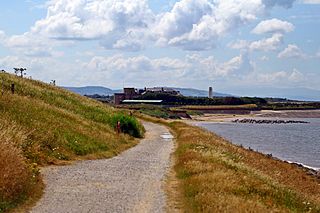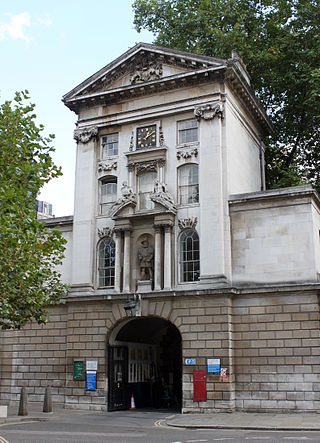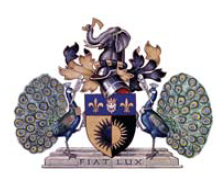Fundraising and associated charities
Founded in 1963, The Friends of Moorfields Charity is an independent registered charity, raising funds for the benefit of the patients of Moorfields Eye Hospital. The primary aim of this charity is to provide supplementary services and equipment for the comfort and well-being of Moorfields' patients and their visitors. It contributes towards buying much needed technical items for professional use in the hospital's clinics, satellite centres, operating theatres and research laboratories. The charity also promotes and manages a wide range of volunteers, supporting the work and service of the hospital. [10]
Moorfields Eye Charity is an independent registered charity for Moorfields Eye Hospital. Moorfields Eye Charity raises funds, above and beyond those normally provided by the NHS, to support and promote the work and research of Moorfields Eye Hospital, for the benefit of patients and staff, by raising extra funds to enhance services, research, equipment and facilities including a major joint – Moorfields and Institute of Ophthalmology, UCL – new building project. [11]
The Special Trustees of Moorfields Eye Hospital (charity number 228064) is a grant-giving body, which primarily supports research carried out at the hospital and research partners at the UCL Institute of Ophthalmology, alongside a range of other projects. [12]

Leasowe is a village in the Metropolitan Borough of Wirral in Merseyside, England. Historically within Cheshire, Leasowe was part of the old County Borough of Wallasey. It is now within the Leasowe and Moreton East Ward of the Metropolitan Borough of Wirral, as well as the Wallasey parliamentary constituency.

The Mater Misericordiae University Hospital, commonly known as the Mater ( "matter"), is a major teaching hospital, based at Eccles Street, Phibsborough, on the northside of Dublin, Ireland. It is managed by Ireland East Hospital Group.

St Bartholomew's Hospital, commonly known as Barts, is a teaching hospital located in the City of London. It was founded in 1123 and is currently run by Barts Health NHS Trust.

The Royal National Orthopaedic Hospital (RNOH) is a specialist orthopaedic hospital located in Stanmore in the London Borough of Harrow, run by the Royal National Orthopaedic Hospital NHS Trust. It provides the most comprehensive range of neuro-musculoskeletal health care in the UK, including acute spinal injury, complex bone tumour treatment, orthopaedic medicine and specialist rehabilitation for chronic back pain. The RNOH is a major teaching centre and around 20% of orthopaedic surgeons in the UK receive training there.
The Seafarers Hospital Society, formerly the Seamen's Hospital Society, is a charity for people currently or previously employed by the British Merchant Navy and fishing fleets, and their families. It was established in 1821.

The Radcliffe Infirmary was a hospital in central north Oxford, England, located at the southern end of Woodstock Road on the western side, backing onto Walton Street.

The London Fever Hospital was a voluntary hospital financed from public donations in Liverpool Road in Islington, London. It was one of the first fever hospitals in the country.

Cromer and District Hospital opened in 1932 in the suburb of Suffield Park in the town of Cromer within the English county of Norfolk. The hospital is run by the Norfolk and Norwich University Hospitals NHS Foundation Trust and provides an important range of acute consultant and nurse-led services to the residents of the district of North Norfolk.

The Hospital of St. Cross is a National Health Service hospital on Barby Road, in Rugby, Warwickshire, England, managed by the University Hospitals Coventry and Warwickshire NHS Trust. It is on the south edge of Rugby above a steep slope running down to the Sow Brook valley.

St Leonard's Hospital is a hospital in Hoxton, London.
Chailey Heritage School is a special school located in North Chailey, East Sussex, England. It is owned and operated by the Chailey Heritage Foundation. The school is for children and young adults, aged between 3 and 19, with complex physical disabilities and associated learning difficulties. The school has a sixth form. It is a charity. There is boarding accommodation on the site. NHS services are based at the same location.

Hounslow Hospital was a small hospital for geriatric and long-stay patients situated in an industrial area of Hounslow, girdled by two motorways and Heathrow Airport. It was run by the Ealing, Hammersmith and Hounslow Area Health Authority.

The Grove Hospital, originally the Grove Fever Hospital, was a hospital for infectious diseases opened in Tooting Grove, London.

The Miller General Hospital was a hospital in Greenwich, London from 1884 until 1974. It was developed adjacent to an earlier dispensary, and was the first British hospital designed with circular wards, and one of the first to have an X-ray department.

The David Lewis Northern Hospital was located in Great Howard Street, Liverpool. It was first established in 1834 and closed in 1978.

The Royal Eye Hospital was established in 1857 by John Zachariah Laurence and Carsten Holthouse as the South London Ophthalmic Hospital.

Annie Sophia Jane McIntosh CBE, RRC was a British nurse and nursing leader. She was a Matron of St Bartholomew's Hospital, London (1910–1927), promoted the fledgling College of Nursing Ltd, and served on several wartime committees.
Gertrude Mary Richards, was a British nurse and military nursing leader during the First World War. She was matron and principal matron in the Queen Alexandra's Imperial Military Nursing Service from 1904 until her retirement in 1919.
Bethnal Green Hospital was an acute care hospital, in Bethnal Green in the London Borough of Tower Hamlets, England. It opened in 1900, and it closed in 1990.

Central London Ophthalmic Hospital, London was a hospital in Gray's Inn Road, London.


















